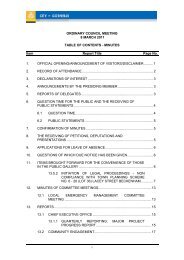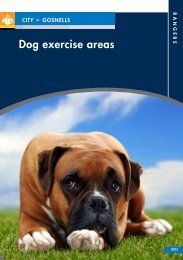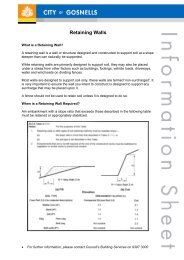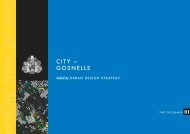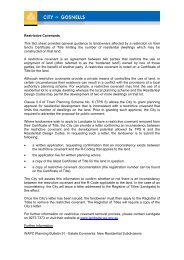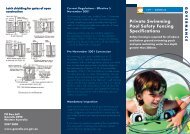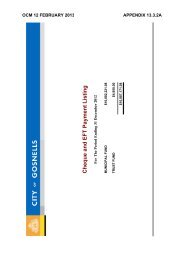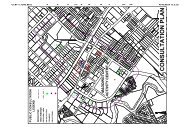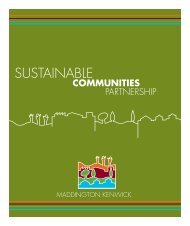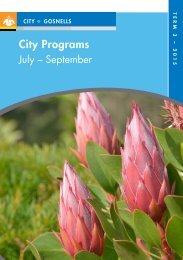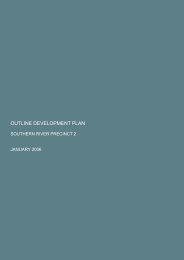Summary - City of Gosnells
Summary - City of Gosnells
Summary - City of Gosnells
You also want an ePaper? Increase the reach of your titles
YUMPU automatically turns print PDFs into web optimized ePapers that Google loves.
Vegetation 60racemosa, *Hypochaeris glabra, Jacksonia floribunda, Kunzea glabrescens, Lechenaultia expansa,*Leptospermum laevigatum, Leucopogon conostephioides, Lomandra hermaphrodita, Lyginia barbata,Macrozamia reidlei, Melaleuca seriata, Nuytsia floribunda, Patersonia occidentalis var. occidentalis,Phlebocarya ciliata, Philotheca spicata, Schoenus curvifolius, Scholtzia involucrata, *Sonchus oleraceus,Stirlingia latifolia, Stylidium repens, Thysanotus manglesianus, *Ursinia anthemoides and Xanthorrhoeapreissii.Vegetation Unit T12: Eucalyptus marginata - Allocasuarina fraseriana low woodland over *Leptospermumlaevigatum tall shrubland over a degraded understorey <strong>of</strong> *Ehrharta calycina - Mesomelaena pseudostygiaopen grasses and sedges.This unit occurred in two blocks in Precinct 1.Vegetation Unit T13: Eucalyptus gomphocephala scattered trees over alien understorey. .Four very small populations <strong>of</strong> Eucalyptus gomphocephala, with a total <strong>of</strong> seven large trees, all well over 10m tall, were recorded near Coldwell Rd, The trees are in Precinct 3B. Large Eucalyptus gomphocephala treeswere also noted in other parts <strong>of</strong> the MKSEA where, judging by the configuration <strong>of</strong> the groves, they werethe result <strong>of</strong> plantings by landowners. However, the Precinct 3B Eucalyptus gomphocephala trees appearedto be a natural occurrence as they were associated with sub-surface calcareous material (in drainage ditchesadjacent to these trees). The presence <strong>of</strong> this material was also strong evidence that this area is naturalEucalyptus gomphocephala habitat. As such, the Eucalyptus gomphocephala in Precinct 3B should befurther investigated as a rare occurrence <strong>of</strong> Eucalyptus gomphocephala on Muchea Limestone and thuspossibly <strong>of</strong> high conservation significance.Vegetation Unit M1: Eucalyptus decipiens subsp. decipiens mid-dense mallee over *Olea europaea tallopen shrubs, patchy open sedges and mid-dense naturalised alien grasses.This unit occurred at one location in Precinct 2, on a palusplain with low, outcropping Muchea Limestone.The artesian spring at this site is no longer active, possibly due to human disturbance. The naturalised aliengrass *Ehrharta calycina and the woody calcicole weed *Olea europaea dominated the understorey. Thecanopy <strong>of</strong> Eucalyptus decipiens subsp. decipiens was, however, more or less intact. The relatively richassemblage <strong>of</strong> native sedges, grasses and herbs that is currently present in the understorey <strong>of</strong> this vegetationwould probably regenerate well if the alien grasses were controlled.Common associates <strong>of</strong> this unit included: Acacia saligna var. saligna, Austrostipa sp. ,*Asparagusasparagoides, Baumea juncea, Conostylis festucacea subsp. festucacea, Corymbia calophylla, Cyathochaetaavenacea,*Cynodon dactylon,*Ehrharta calycina, Hakea prostrata, Lomandra hermaphrodita,Lepidosperma longitudinale, Lepidosperma pubisquameum sens. lat., Lyginia imberbis, *Melinis repens,Neurachne alopecuroidea, Nuytsia floribunda, Patersonia occidentalis var. occidentalis, Schinusterebinthifolius, Tetraria octandra, Tricoryne elatior and Xanthorrhoea preissii.Vegetation Unit ST1: Actinostrobus pyramidalis tall open shrubs over Melaleuca seriata, Jacksoniasternbergiana, Melaleuca viminea and other shrubs.This vegetation unit occurred in Precinct 3B just south <strong>of</strong> Yule Brook. It appeared disturbed due to heavyweed invasion but was considered to have good potential for restoration. This area (and other similar areas inthe MKSEA along Yule Brook) were once probably thick scrubs, similar to that still found in the floodplainareas adjacent to a tributary <strong>of</strong> Yule Brook in the University <strong>of</strong> Western Australia Allison Baird FloraReserve in Bush Forever Site 387. They are likely to retain species-rich, native soil seed banks and could berestored to thick scrubs given a moderate management input and remediation <strong>of</strong> the hydrological regime <strong>of</strong>Yule Brook. Meanwhile, the dense scrub, woody litter and the dense grass weeds in areas like this alongYule Brook provide good native fauna habitat and form part <strong>of</strong> an important fauna corridor from the DarlingRange to the Canning River.Associates <strong>of</strong> this vegetation included: Acacia lasiocarpa var. lasiocarpa sens. strict., Acanthocarpuscanaliculatus, Astartea scoparia, UCassytha racemosaU, Cyathochaeta avenacea, Drosera glanduligera,Gonocarpus nodulosus, Hakea trifurcata, Hakea varia, Hypocalymma angustifolium Mud Habitat Variant(C.Tauss 1850), Kunzea micrantha subsp. micrantha, Lomandra micrantha subsp. micrantha, Melaleucaincana subsp. incana, Melaleuca lateritia, Melaleuca osullivanii, Neurachne alopecuroidea, SchoenusTauss, C. and Weston, A.S. (2010). The flora, vegetation and wetlands <strong>of</strong> the Maddington-Kenwick Strategic Employment Area.A survey <strong>of</strong> the rural lands in the vicinity <strong>of</strong> the Greater Brixton Street Wetlands. Report to the <strong>City</strong> <strong>of</strong> <strong>Gosnells</strong>, W.A. Version 18.04.10



